Heavy tank Porsche VK 3001 (P), Germany
The development of a promising heavy tank at Porsche began no later than mid-September 1939, and the work was initiated as an initiative. The management of the organization learned about the previous orders of the Armaments Department, which had attracted other companies to the development of the required equipment, and decided not to stand aside. Already on September 27, the military received a letter from Ferdinand Porsche, which proposed the overall look of a new version of a heavy tank. After this work on the creation of a new project continued.
Until the end of 1939, specialists from Porsche were working on the look of the new armored vehicle. It was planned to improve the level of protection in comparison with the existing equipment, to ensure the required characteristics of mobility, as well as to use powerful weapons. It was originally intended to equip a tank with a 75 caliber mm gun. Later decided to consider the option of using 105-mm guns. Work on the choice of weapons seriously delayed. Choose the final version of the main weapons succeeded only at the beginning of 1941.
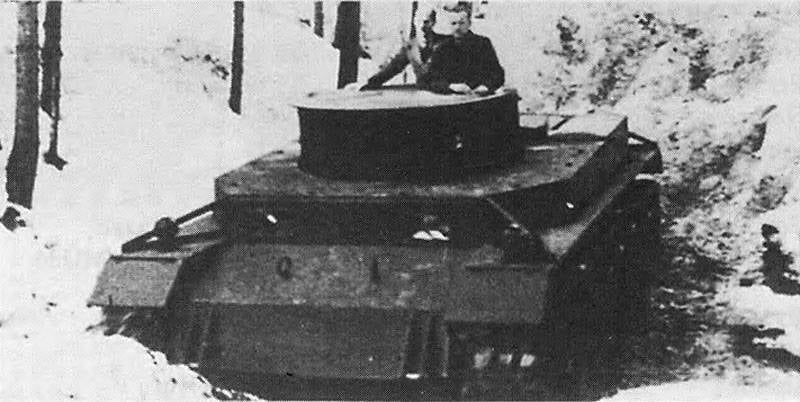
VK 3001 (P) prototype on tests. Photo of Chamberlain P., Doyle H. "Complete reference book of German tanks and self-propelled guns of the Second World War"
According to reports, during the last months of 1939, Porsche developed six variants of the draft design of a heavy tank, as well as five versions of their improvement. The appearance of the car was formed without taking into account the requirements of the potential customer, however, in these works, the feedback and wishes of tank-soldiers were actively used. Thus, it was possible to count on a significant increase in the operational characteristics of technology in comparison with existing samples.
The initiative project of the Porsche company received the working designation Typ 100. In addition, at a certain stage, the development acquired the name Leopard. After the completion of the main design work and obtaining approval from the army, the promising heavy tank received the official designation VK 3001 (P) - “Prototype weighing 30 tons, the first version, by Porsche”.
At the beginning of December 1939, the specialists of the developer firm decided on the main features of a promising project. It was proposed to use relatively thick armor capable of protecting equipment from various threats, powerful weapons and the original version of the transmission. The necessary documents and drawings were prepared. At the very beginning of 40, this version of the project was presented to the Armaments Department, which was interested in the initiative development.
According to the results of the analysis of the presented preliminary draft, the army agreed to finance the further work. In addition, it was approved to attract subcontractors to the works. Over the next few months, the lead developer of the project, represented by Porsche, signed several agreements with other organizations that were to be responsible for the development and manufacture of various components and assemblies.

Chassis diagram VK 3001 (P). Figure Baryatinsky MB "Heavy tank" Tigr "" // "Armored collection"
The following months were spent on completing the design and preparation of the finished project. The result of this work was the emergence of all the necessary documentation, in accordance with which the advanced tank chassis should have been built. Development of the tower, in turn, faced some difficulties. Due to the lack of a final decision on the main armament, the structure of the tower had to be changed several times. In addition, it was processed in connection with updating customer requirements.
New heavy tank VK 3001 (P) was supposed to get an armored corps with high protection performance. Thus, it was proposed to manufacture the frontal part from armor plates up to 80-100 mm thick, located at different angles to each other. Protection of the onboard chassis projection was assigned to 60-mm parts. The stern used armor 40 mm thick, and the roof and bottom had a thickness 26 mm.
The frontal part of the hull was formed by the traditional for German tanks of the time box-shaped construction of several sheets. The upper frontal sheet was located with a minimum deviation from the vertical and had several openings for the installation of viewing devices. The sides of the hull were divided into two parts. Their upper elements were spaced apart in relation to the lower ones and formed developed fenced niches. A curious feature of the corpus, which distinguished it from some other technology, was beveled cheekbones, connected to the forehead. The entire length of the hull, with the exception of the stern, had a horizontal roof. Her feeding area was littered back.
The layout of the hull was to correspond to the basic ideas used in the German tank building of the time. At the same time, it was proposed to rework it because of the use of new ideas and solutions. In front of the case, the volume was kept to accommodate the transmission units, next to which there was a control compartment. The entire central part of the machine was given under the fighting compartment, and the power plant units should be placed in the stern.
Until a certain time, work on the creation of a tower for a new tank did not have much success. Due to the continued search for suitable weapons, the development of a full-fledged draft of the tower was inappropriate. However, already in the early stages of the project, a variant of the tower with a sloping frontal sheet and curved sides was proposed. A two-roofed roof with sloping front and rear was also envisaged. In terms of protection, the tower had to fit the body, getting armor up to 80-100 mm thick.
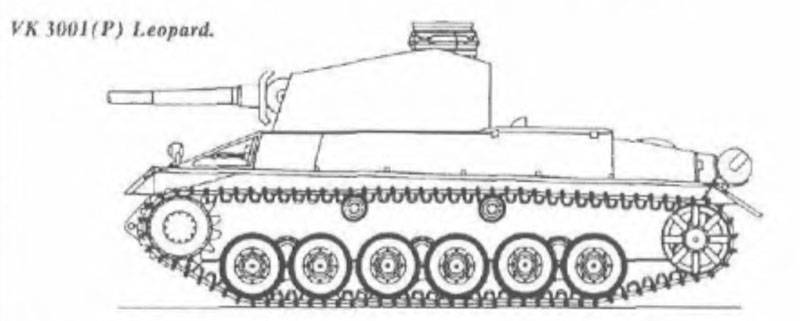
The scheme of a full-fledged heavy tank with a turret and weapons. Figure Baryatinsky MB "Heavy tank" Tigr "" // "Armored collection"
The basis of the power plant of the VK 3001 (P) tank was to be two Porsche Typ 100 carburetor engines with an 210 power of hp. each. Air-cooled engines, fuel tanks and other systems were to be placed in the feed compartment of the vehicle. In addition, it was proposed to place two electric generators by Siemens-Schukkert, used in the transmission, next to the engines. Each engine was planned to mechanically connect with its own generator.
Even during the preliminary work on the new project, Porsche's specialists came to the conclusion that the “classic” mechanical transmission was limited. Similar units had limited characteristics, and also did not differ in simplicity of operation. For this reason, and also in view of the absence of restrictions imposed by the customer, it was decided to apply the original transmission based on electrical units in the new project “Type 100”. The engine torque should have been transmitted to the drive wheels without the aid of mechanical devices. Instead, it was proposed to use generators, wires and traction motors. Planetary and friction gears were also present between the latter and the driving wheels. The operation of the tracked propulsion unit was to be controlled by monitoring electrical systems.
An undercarriage of unusual design was proposed. On each side of the tank should be placed on six road wheels with a diameter of 700 mm, equipped with rubber bands. The rollers were blocked in pairs, and their carts received a torsion bar suspension. In order to save space and simplify the design of the armored car, torsion bars were located outside the armored body, and were also placed along its axis, and not across. Driving wheels were placed in the front of the hull, guides - in the stern. There were four pairs of supporting rollers. A large caterpillar with a width of 500 mm was used.
The composition of the weapons promising tank for a long time remained the subject of controversy. By the spring of 1941, the work on the choice of weapons moved to the stage of ground tests. In the course of specially conducted tests, it was found that the most interesting tools are the 88 and 105 mm calibers. 75-mm guns, in turn, no longer met the requirements of the time due to the relatively low characteristics of armor penetration. According to the test results, it was decided to focus on the 88 caliber system mm.
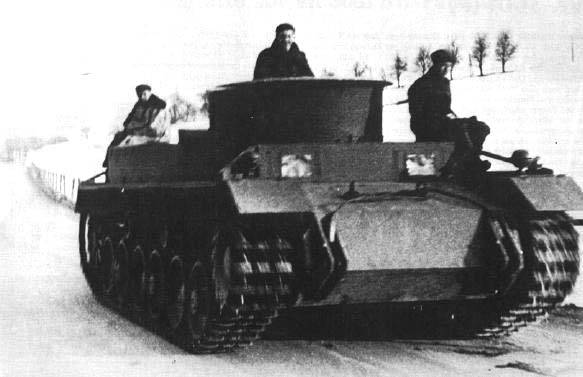
Experienced chassis on trial. Photo Aviarmor.net
The decision to use the 88-mm gun 8,8 cm KwK 36 was made at the very beginning of April 41. However, despite this, the first version of the tower was developed under the 105-mm gun. Documentation on the tower with the required weapons was presented a few days later. 24 On April, the KwK 36 turret project was approved and recommended for use as part of a new heavy tank.
Thus, the main weapon of the VK 3001 (P) tank was to become a KwK 36 gun of the 88 mm caliber with electric ignition. Having a barrel length 56 caliber, such a weapon could accelerate projectiles up to speeds of the order of 930 m / s and punch up to 140 mm homogeneous armor at a distance of 1 km. The nomenclature of ammunition guns included several unitary shots with shells for various purposes. The gun was proposed to be mounted on a rocking installation in a rotating tower. Due to this, guidance could be performed in any direction horizontally in a certain vertical sector.
Additional armament of the tank was to consist of two MG 34 machine guns of 7,92 caliber mm. One of the machine guns was placed on the gun installation and served as a twin weapon, and the second was located in the front embrasure of the hull, in the place of the gunner-radio operator.
The crew of the advanced heavy tank was asked to include five people. Inside the case were jobs mechanic-driver and gunner-radio operator. They were placed in front of the hull and fell into place through the hatches in the roof. In the frontal parts of the case there were viewing devices. In the fighting compartment there were places gunner, commander and loader. At their disposal there were hatches in the roof, as well as a set of viewing devices, including those mounted on the commander’s turret.
Despite the use of very thick and heavy armor, the authors of the project managed to maintain the combat weight of the tank at the level of 30 m. The length of the vehicle reached 6,58 m, width - 3,8 m, height - 3,05 m. The calculated maximum speed on the highway should reach 60 km / h. Such characteristics could make VK 3001 (P) one of the most protected and mobile armored vehicles in its class.
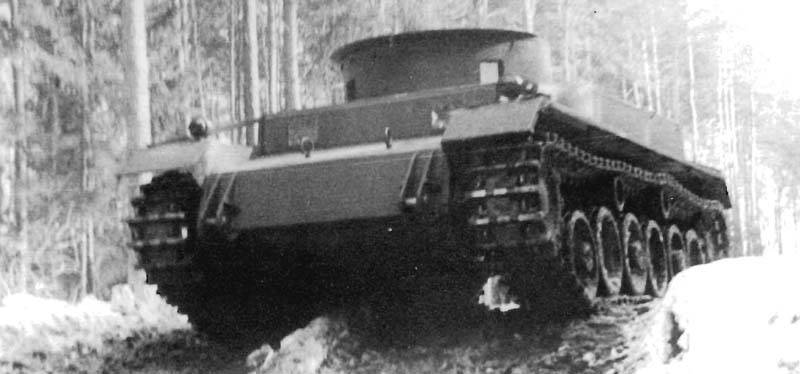
Cross-country movement. Photo Aviarmor.net
In the spring of 1941, after the armament complex was approved on the basis of the 88-mm cannon, the customer and the project implementers agreed on the allocation of responsibilities for the construction of the prototype. Thus, the general assembly of an experimental tank was assigned to the Niebelungennwerke plant. For the supply of armor parts of the hull and the finished tower answered the firm Krupp. Siemens-Schukkert was required to supply the necessary electrical systems. Also, some other suppliers of certain products were involved in the project.
In May, 41-th were signed several new contracts for the supply of units for experimental equipment, which, among other things, stipulated the terms of execution of works. According to these documents, the first prototype of VK 3001 (P) was supposed to appear at the end of autumn, and the third of the required machines could be put to the test early next year. In addition, in the foreseeable future, the customer required to modify the design of the tower and use its updated version on prototypes. The new version of the tower was designed and implemented as a layout in 20 May. A few days later she was shown to the customer.
For various reasons, the VK project 3001 (P) was seriously delayed. Design work started at the end of 1939 and continued until the start of 41. After the approval of plans for the construction of experimental equipment, it turned out that the assembly of three prototypes could face additional difficulties that could lead to the next shift of deadlines. The management of the company-developer had to take some measures aimed at accelerating the work.
The company Porsche, seeing the problems of subcontractors, attracted to the plant Eisenwerke Oberdonau. He had to build a hull for an experienced tank without protection. To speed up the work and quickly start the test, it was decided to assemble a tank hull of structural steel. Work on this product began in May, and ended before the end of June. Finished units sent to the company Niebelungennwerke for the final assembly of an experienced tank.
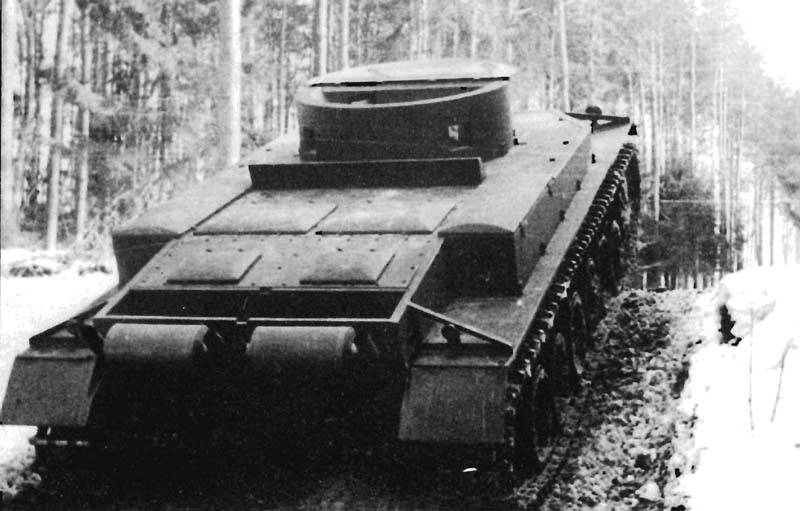
Rise on a slope. Photo Aviarmor.net
In early June, Steyr assembled the first of two necessary Porsche Typ 100 engines. At the end of July, the second such motor was introduced, after which both products went to the assembly shop for installation in the existing housing. Deliveries of various components with their installation in an unprotected package continued until the autumn of 1941. In October, the first experimental tank VK 41 (P) with a housing made of structural steel and a weighing simulator instead of a tower was presented to the 3001.
There is also information about the assembly of the second experienced chassis of the new model. It received a complete set of necessary systems and was built on the basis of a full-fledged armored corps. The second prototype could become the first prototype machine, but in the first half of 1941, the construction of the equipment was delayed, due to which the developers had to initiate the construction of a simplified chassis without the required protection. Like the first prototype, the second experimental car had towers and carried a weight simulator on the roof.
Tests of two chassis prototypes showed that, in its current form, the VK 3001 (P) tank has both advantages and disadvantages. For example, the existing reservation made it possible to protect the crew and internal units from a variety of artillery systems, but in some situations it could not be sufficient. It was necessary to refine and strengthen the protection. The fighting qualities of a heavy tank could not be verified. The assembly of the towers was seriously delayed, which is why both prototypes ended up without weapons.
The power plant, transmission and chassis of experienced armored vehicles showed themselves ambiguous. During the tests, there were regular failures of various suspension elements, which were not distinguished by high reliability. There were also constant problems with electric transmissions. At the same time, electric transmission was considered a convenient and promising option for equipping heavy-duty prospective armored vehicles. It was expected that after the elimination of all identified deficiencies such systems would be able to significantly improve the characteristics of tanks and other machines.
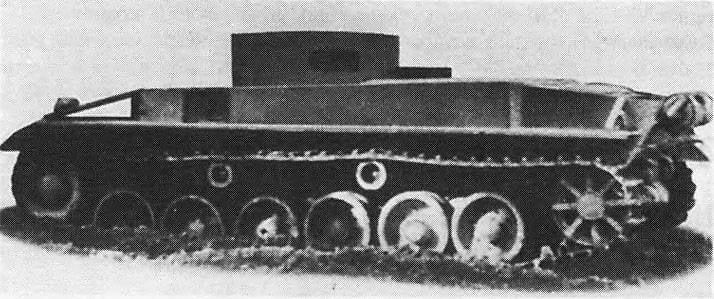
Experienced chassis, port side. Photo of Chamberlain P., Doyle H. "Complete reference book of German tanks and self-propelled guns of the Second World War"
The project of the heavy tank Typ 100 / VK 3001 (P) had certain advantages over other developments of that time and was of some interest from the point of view of further development. However, in the time elapsed from the start of the design to the start of the tests, the customer’s requirements had changed, and the project itself was to some extent outdated. Finishing of the existing chassis, checking the turret with weapons for it and other stages of the project required further time, effort and funding. For this reason, the feasibility of continuing work was in doubt.
Back in May, the 1941 of the year, when the schedule for the construction of the experimental tanks VK 3001 (P) was determined, the German command proposed a new concept of a heavy tank, which had noticeable differences from the existing views on such equipment. Requirements for the protection, arming and mobility of such heavy tanks were discussed. Soon the terms of reference were drafted, according to which the contracting firms were to lead the development of two projects. A variant of the heavy tank from the company Porsche received the designation VK 4501 (P), and the company Henschel commissioned the creation of the machine VK 3601 (H). The two heavy tanks were supposed to have some differences, but they were considered as alternatives to each other. By the summer of 1942, both tanks were supposed to be tested.
Using existing experience and developments in existing projects, including VK 3001 (P), Porsche developed a new version of the heavy tank rather quickly, and then built a prototype. The first prototype of such an armored vehicle was ready in April 1942 of the year. A new hull with thicker armor was created, in which the modified powerplant and electrical transmission were placed.
The progress achieved during the VK project 4501 (P) has seriously affected the prospects of VK 3001 (P). Due to significant advantages over its predecessor, as well as the absence of problems with the construction of prototypes, the new development was of greater interest to the customer. Such circumstances could not affect the further course of work on the creation of a new heavy tank. The 30-ton combat vehicle was considered unpromising and unable to compete with a newer tank.
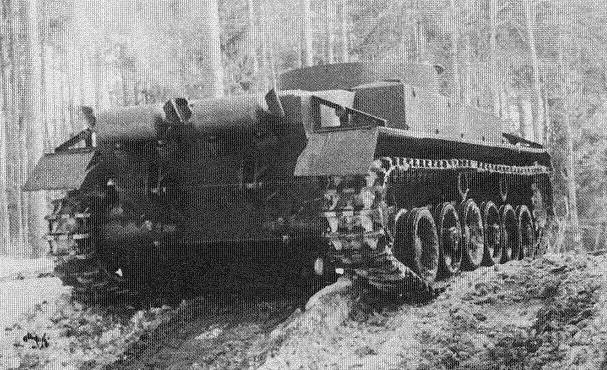
The prototype overcame the climb, rear view. Photo Aviarmor.net
Tests of prototype machines VK 3001 (P) continued until May 1942. After that, it was decided to stop the development of this project as not meeting the new requirements. All the forces of the Porsche designers were focused on new developments, which were distinguished by higher characteristics and, as a result, had certain prospects.
As far as is known, for several months after the project was closed, the operation of two Typ 100 / VK 3001 (P) prototype chassis continued in the interests of the further development of armored vehicles. These machines were used as mobile platforms for working out certain ideas and solutions. The prototypes of the heavy tank were engaged in the VK 4501 (P) program and were used as additional experimental machines. After completing all the necessary checks and tests, both samples were dismantled for metal. The need for this technique was no longer present, while the materials and aggregates used could be used again.
During the VK 3001 (P) project, only two experienced chassis were built, one of which also had a housing made of structural steel. In addition, both prototypes did not have towers, the development and assembly of which was too much delayed and eventually were canceled along with further work on the main project. The project of a promising heavy tank company "Porsche" in its original form did not give real results and did not lead to the rearmament of armored units.
Nevertheless, he allowed a number of original ideas to be brought to practical implementation and testing under the conditions of the test site. Subsequently, developments in the tank VK 3001 (P), such as electric transmission, the relevant principles of machine control, etc., were used in some new projects. However, in this case there was no talk of a massive use of original ideas.
Based on:
http://aviarmor.net/
http://achtungpanzer.com/
http://armor.kiev.ua/
Chamberlain P., Doyle H. Complete reference book of German tanks and self-propelled guns of the Second World War. - M .: AST: Astrel, 2008.
Baryatinsky M.B. Heavy tank "Tigr" // Armored collection. 1998. No.6.
Information